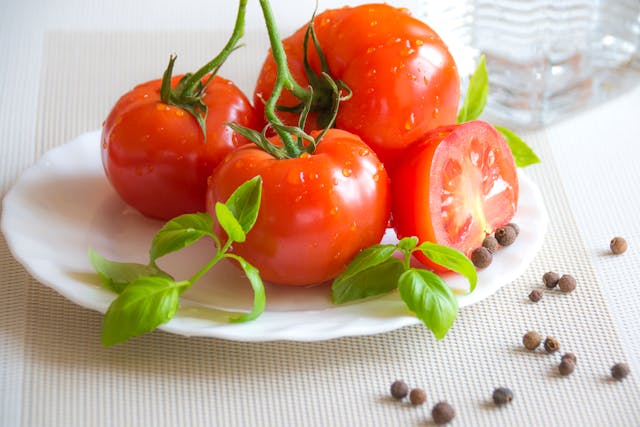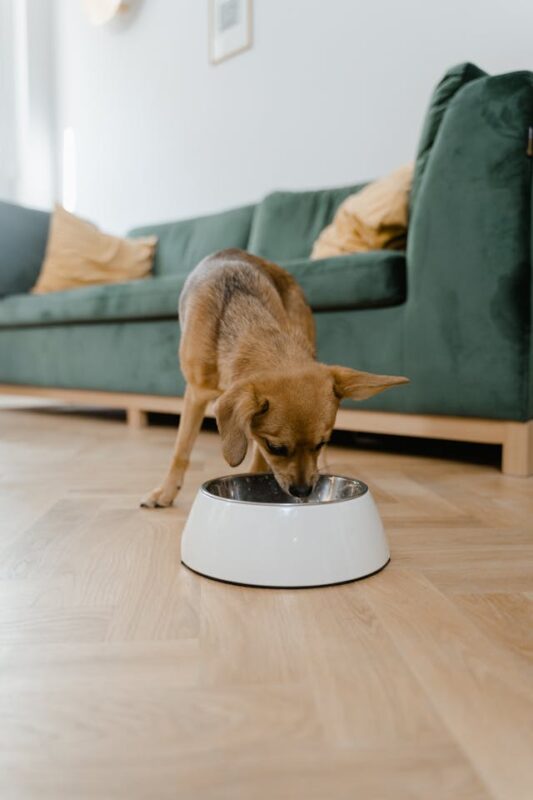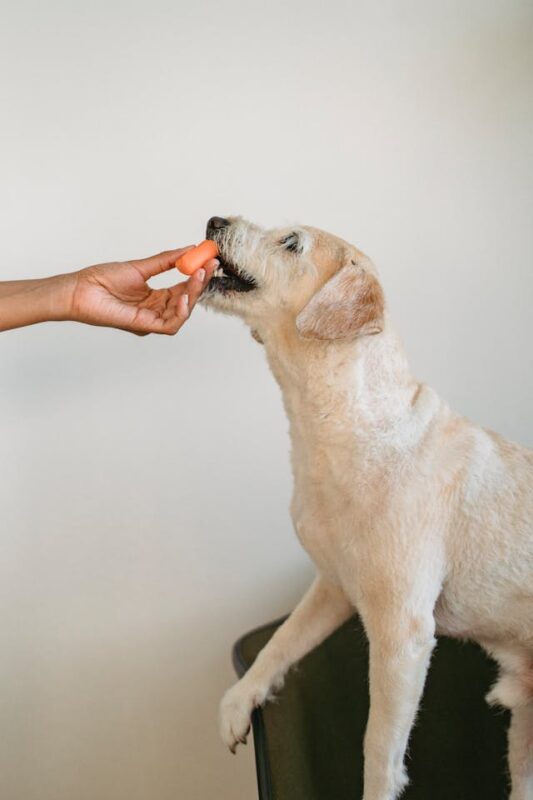Can Dogs Eat Tomatoes?
Posted: 02/24/2025 | BY: Jenna Bruce | Categories: Dog , Pet care , Top Tips
Tomatoes: they’re vibrant, delicious, and a staple in so many human meals. But if you’re a dog owner, you’ve probably wondered—can dogs eat tomatoes? Are they a tasty, nutritious snack or a risky food best kept off their menu?
The short answer? Yes… but with some important caveats!
Let’s dig into everything you need to know about feeding tomatoes to your furry best friend, including the benefits, risks, how to safely share this juicy fruit, and what to do if your dog accidentally eats the wrong part of the plant.

The Good News: Are Tomatoes Safe for Dogs?
Ripe, red tomatoes are generally safe for dogs in moderation. They contain beneficial vitamins, minerals, and antioxidants that can support your dog’s health, including:
Vitamin C – Helps boost the immune system and fight off free radicals.
Vitamin A – Supports eye health, skin health, and a shiny coat.
Lycopene – A powerful antioxidant that may help reduce the risk of chronic diseases and inflammation.
Fiber – Aids digestion and promotes gut health.
Potassium – Supports heart health, muscle function, and nerve signaling.
Because tomatoes are low in calories and high in water content, they can also be a hydrating, refreshing treat on a hot day. They may even help slightly freshen your dog’s breath due to their natural acidity!
However, while the ripe fruit is safe, not all parts of the tomato plant are dog-friendly.
The Not-So-Good News: When Are Tomatoes Dangerous?
Tomatoes belong to the nightshade family, which means they contain solanine and tomatine, two compounds that can be toxic to dogs in large amounts. These substances are mostly concentrated in:
Green, unripe tomatoes – Higher levels of tomatine can cause stomach upset, lethargy, or even more serious reactions.
Leaves, stems, and vines – The green parts of the tomato plant contain the most solanine and tomatine and should never be given to dogs.
Signs of Tomato Poisoning in Dogs
If your dog eats too much tomatine or solanine from unripe tomatoes, stems, or leaves, you may notice:
- Gastrointestinal distress (vomiting, diarrhea, stomach pain)
- Excessive drooling
- Lethargy or weakness
- Dilated pupils
- Tremors or muscle weakness
- Changes in heart rate or breathing
A small bite of a green tomato or a leaf is unlikely to cause severe toxicity. However, if your dog has eaten a significant amount, call your veterinarian immediately.
How to Safely Feed Tomatoes to Your Dog
If you want to share a tomato with your pup, follow these simple steps:
Choose ripe, red tomatoes – Avoid green tomatoes and any parts of the plant.
Wash thoroughly – Pesticides and dirt can be harmful to your dog.
Remove the stem and leaves – Stick to just the fruit.
Cut into small pieces – This helps prevent choking and makes digestion easier.
Start with a small amount – Introduce tomatoes slowly to ensure your dog tolerates them well.
💡 Pro Tip: Stick to plain tomatoes—no seasonings, sauces, or added ingredients. Many tomato-based products (like ketchup or pasta sauce) contain garlic, onions, salt, or sugar, all of which can be toxic to dogs.
Which Dogs Should Avoid Tomatoes?
While many dogs can enjoy tomatoes in moderation, some should avoid them altogether, including:
Dogs with sensitive stomachs – Tomatoes can be too acidic for some pups and may cause mild digestive upset.
Dogs with kidney issues – The potassium in tomatoes may not be suitable for dogs with kidney disease.
Dogs with arthritis – Some vets believe that nightshade vegetables may contribute to inflammation in arthritic dogs.
Dogs with food allergies – While rare, some dogs may have an allergic reaction to tomatoes.
If your dog falls into any of these categories, play it safe and opt for a different snack.
Can Dogs Eat Cherry Tomatoes, Grape Tomatoes, or Other Varieties?
Yes! The same general rule applies—as long as they are ripe and red, they are safe in moderation. However, because cherry and grape tomatoes are smaller, they can pose a choking hazard for small dogs. Always slice them into bite-sized pieces before serving.
Can Dogs Eat Tomatoes When Cooked?
Yes, but with caution. Plain cooked tomatoes (without added ingredients) are generally fine for dogs. However, avoid tomato-based dishes that contain:
Garlic and onions – Both are highly toxic to dogs.
Salt and spices – Excessive salt can cause sodium poisoning.
Sugar – Not toxic, but unnecessary and unhealthy for dogs. Although xylitol, a sugar substitute, can be deadly to dogs if ingested.
That means no pasta sauce, ketchup, salsa, or tomato soup for your pup!
Fun Tomato Alternatives for Dogs
If you’re looking for other tasty, dog-safe treats, consider these options:
Carrots – Crunchy, sweet, and great for dental health.
Bananas – A soft, naturally sweet snack (in moderation).
Cucumbers – Low-calorie, hydrating, and perfect for summer.
Watermelon (seedless) – A refreshing treat on a hot day!
These alternatives are not only safe but also packed with vitamins and hydration benefits.
Final Thoughts: Can Dogs Eat Tomatoes?
At the end of the day, ripe, red tomatoes are safe for most dogs when given in moderation, but unripe tomatoes, stems, and leaves should be avoided.
If your dog accidentally eats part of a tomato plant or an unripe tomato, monitor them closely for symptoms and call your vet if anything seems off. When in doubt, always check with your veterinarian before introducing a new food into your dog’s diet.
One Last Thing: Have You Considered Pet Insurance?
Accidental ingestion of toxic foods is one of the most common reasons for emergency vet visits. Whether it’s a sneaky bite of a dangerous plant or an unexpected health issue, pet insurance can help cover unexpected medical costs and give you peace of mind.
Because when it comes to your furry friend’s health, it’s always better to be safe than sorry! 🐶❤️
Disclaimer
The information contained on this blog is intended for informational and educational purposes only and should not be construed as medical advice. It is not a substitute for professional veterinary care. Always consult with your veterinarian before making any changes to your pet's health care or treatment plan.
The authors of this blog are not veterinarians and do not claim to be experts in pet health. The information provided here is based on our own experiences and research, as well as information from reputable sources. However, we cannot guarantee the accuracy or completeness of this information.
We encourage you to do your own research and consult with your veterinarian before making any decisions about your pet's health.
Previous post
The 10 Most Popular Cat BreedsCompare top pet insurance providers & plans.
Enter your dog’s age in years and months to calculate their age equivalent to human years.
Calculate your dog’s ageEnter your cat’s age in years and months to calculate their age equivalent to human years.
Calculate your cat’s age


